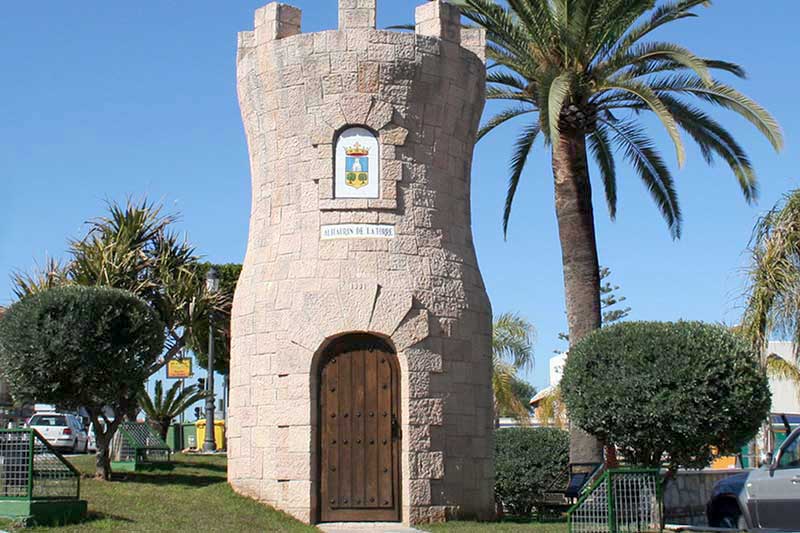Alhaurín de la Torre, a spanish village in the province of Málaga, in Andalucía, is located between the Mountains of Mijas and the Valley of the Guadalhorce River. 17 Kms. far from Málaga city and 8 Kms far from the airport, it is also possible to get to Alhaurín through the bypass of the road Churriana – Cártama across the country.

The most important mountain is Jabalcuza, between Alhaurín de la Torre and Torremolinos. The Guadalhorce river goes along the edge of the north of the village and its most important streams (“Deep stream”, “Cat’s stream” and “Flat Mountain stream”) pour in it.
Alhaurín de la Torre has paleolithic rests and it was probably founded in Gades times, more than 3.000 years ago, when the phoenicians succeded in their periplus and left their first signs next to the near Malaca. Doing an etimologic study of the origen of the name of the village we can have a look at the proud past of Alhaurín de la Torre:
First it was called Lauro Vetus (Old Bay Leaf), Laurona and Laura Bética, where Cneo Pompeyo’s death is located by Julio César’s supporters in 45 B.C., after being defeated in the battle of Munda.
When Lauro Vetus was conquered by the muslims, they called it Albarracín what we could understand as Albaicín (nest of falcons) or more sure Albah-Aharrín (merciful God), of which it would derive Alhaurín de la Torre. Romans and arabics had Alhaurín as a bath. In more recent times, the springs of Alhaurín de la Torre cured ulcers and other ilnesses.
The Reconquest of Alhaurín de la Torre, in 1.485, marks the decisive point in the christianness an the Catholic Monarchs give our village its actual name.
At the begining of the XVI, several Alhaurín de la Torre neigbours (Moorish) took part in the revolt of the Serranía de Ronda, which was crushed by christian troops. In 1.502 it is done plublic the verdict of the lawsuit that Alhaurín de la Torre had with Málaga city, that favour the city, which it must be handed Pimentel Towers (Torremolinos nowadays).
After, the ninth of July of 1.812, people of the village lashed bravely the French troop in the place known laster as “Los Caracolillos”. In the early hours of the fifth of December of 1.831 and in the country estate called “La Alquería”, the general José María Torrijos and his companions were arrested by the governor of Málaga, González Moreno.
An important piece of information about the importance of Alhaurín de la Torre is that Churiana and Torremolinos were up its juryness.
It is a very real topic to say the festive and cheerful character of any village of Málaga as Alhaurín de la Torre is, where almost every month has got its festival. Who hasn’t heard about the Torre del Cante or the healthy rivality between the Greens and the Purples Brotherhoods?
- 5th of January – The three Wise Men
- 20th of January – Festival in Saint Sebastian honor, village patron saint.
- 2nd of February – The “Candelá”. The night before dolls are burn and a tradicional procession in the morning with bread offered to the Virgin.
- In February – Carnivals.
- In Easter – We can point out Holy Thursday with the procession of Father Nazarene Jesu and Very Saint Mary of the Dolors Real Brotherhood (the Purples) , the Good Friday with the procession’s Very Saint Christ of the Truth-Cross and Our Lady of the Loneless Brotherhood (the Greens) and Sunday with the Rised from the Dead Jesu (The Whites).
- Corpus Christi Day- The streets of the village are covered with green rush, white sheets and rich altars.
- 24th of June – Main festival of Saint John Baptism. We celebrate the fair and in the following week, the pilgrimage. The famous Flamenco Festival “The Tower of the Cante” (La Torre del Cante”) is in those days too.
The popular kitchen of the country has got tasty dishes. Young people can learn the easy recipes of the elderly people’s wise advice. In the bars and restorants of Alhaurín de la Torre you have to ask for these popular dishes: Rice with chestnuts: It is typical in Easter. Its main ingredients are rice, reed honey and dry chestnuts. Boiled soup consists in soaked bread with olive oil, garlic, peppers, onions and tomatoes. Cachorreñas. You accompany it with boiled sweet potatoes after you have squeezed a sour (cachorreña) orange. A well kept secret that the visitor will find out. Porridge. Bread cut into squares is fried.Then you take it out and empty it out boiling water with salt. Mix flour and wait a little until you can see bubbles in the plaste. Wait a little and it will be ready to taste.
Because of its situation, between Guadalhorce River and Mijas Mountains, Alhaurín de la Torre has become an area of a prospered agrarian production. Known because of its citrus fruits (oranges and lemons) and also prolific in olive trees, almond trees growing and subtropical fruits as avocados and custard apple.Sugar cane and sweet potatoes plantations are important. From the richness of the lands goes out a lot of nursery gardens that impregnate the air with good smell and in its fields, thyme and rosemary. There is a lot of mediterranean scrub in the north and pine in the south.
About fauna it points out typical comunities of scrub in degradation and mediterranean mountains: foxes, mice, moles and snakes. About birds we can find eagles and owls. There are important colonies of shews, rabbits, hares and partridges. Their space is reduced because of the boom of the residencial development.
In the last years, Alhaurín de la Torre has turned into a residencial town with more than 20.000 inhabitants, where the big urbanitations with gardened areas and opened spaces in all the town council and in both sides of the city centre, have grown. 8 districs and 24 housing estates complete the city centre. Districs: El Peñón, Molina, Zapata, Santa Amalia, El Romeral, Torrealquería, Alquería, Mestanza. Urbanitations: Vaguadade la Sierra, Casasblancas, Tabico, El Lagar, Cortijos del Sol, Terrazas del Valle, Bellavista de Zambrana, Retamar, La Capellanía, Los Manantiales, Fuensanguínea, Ermita del Cerro, Juncos de la Ermita, El Cordobés, Huerta Alta, Villamonte, Pueblo Alamillo, Altos de Viñagrande, Platero, Pinos de Alhaurín (the second biggest residencial development in Europe).
Nowadays, Alhaurín de la Torre is the third village of the province of Málaga with the biggest growth population in the last years, which has favoured the transformation from a quiet agricultural village into an important centre of wealth in the industry and the tourism. It is located 17 Kms far from Málaga city and 8 Kms from West Sun Coast. The popular saying “between the sea and the mountain” is well applied. In five minutes we are quietly at the beach or at the international airport, or in 15 minutes we can be shopping in the shopping centre of the capital of the Sun Coast.



